Day of the Dead, or Día de los Muertos, is a vibrant celebration rooted in Mexican culture. Often misunderstood outside of Mexico, this holiday is a joyful celebration of life, memory, and family. Families welcome the spirits of deceased loved ones home with rituals, foods, and colorful decorations.
Whether you live in Mexico or you’ve moved away and you’re far from home, these traditions can help you feel connected to your heritage and to those who came before you.
In this Remitly blog, we’ll explore the origins of Day of the Dead, its key customs, and regional variations, while offering practical ways for families worldwide to participate respectfully.
What is Day of the Dead?
At its heart, Day of the Dead celebrates life rather than mourning. Unlike the somber tone of many Western funerals, this holiday emphasizes remembrance, gratitude, and the ongoing presence of those who have passed in the hearts of their loved ones.The celebration occurs over two days each year. November 1st is dedicated to Día de los Angelitos, or Day of the Little Angels, honoring deceased children. November 2nd, simply Dia de los Muertos, focuses on honoring adults.
During this time, families welcome the spirits of loved ones, sharing food, stories, and music in their memory. Preparations often begin weeks in advance, with trips to local markets for ingredients and candles, as well as cleaning and decorating graves to turn cemeteries into vibrant gathering places.
For families living far from home, these practices help maintain cultural ties and keep ancestral memories alive.
A common misconception is viewing this holiday as a “Mexican Halloween.” While Halloween focuses on costumes and fright, Day of the Dead emphasizes memory, family, and spiritual connection, recognizing death as a natural part of life and celebrating those who are no longer with us.
The history of Day of the Dead traditions
The origins of Day of the Dead date back over 3,000 years to indigenous civilizations such as the Aztecs, Maya, and other pre-Columbian societies. These cultures celebrated death as part of life’s natural cycle, creating rituals to honor deceased ancestors and maintain spiritual bonds.
When Spanish colonizers arrived in the 16th century, Catholic observances like All Saints’ Day (November 1st) and All Souls’ Day (November 2nd) merged with indigenous practices. These different traditions coming together is what shaped the modern Dia de los Muertos, a unique combination of pre-Columbian and European religious customs.
Over the centuries, this holiday became a cultural cornerstone of Mexican life. UNESCO recognized Day of the Dead as an Intangible Cultural Heritage of Humanity in 2008, marking its significance as a living practice that connects communities, families, and generations
Key Day of the Dead traditions and their meanings
We’ve had a look at the origins and history of Day of the Dead, so what does it look like today? Here are some of the typical traditions.
Building the ofrendas (altars)
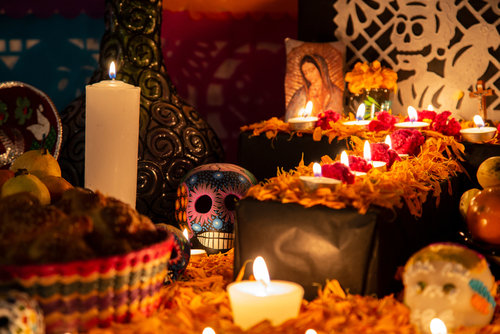
One of the most important Day of the Dead traditions is the ofrenda, or altar, which provides a welcoming space for spirits to come home.
Ofrendas are built in three levels, representing Earth, purgatory, and heaven. Each element also carries a symbolic meaning:
- Photos of loved ones to capture their presence and personality.
- Candles to guide spirits on their journey.
- Copal incense to cleanse the space and call the spirits home.
- Water and salt symbolize spiritual nourishment and purification.
- Favorite foods and personal items, like clothing, toys, or keepsakes, offer comfort and familiarity to returning ancestors.
Creating an ofrenda is both an artistic and spiritual act. It encourages participation across generations, fostering family cohesion and storytelling. Public altars, too, are often extremely elaborate, showcasing the devotion and creativity families pour into this tradition.
Traditional foods and their symbolism
Food is central to the Day of the Dead, connecting the living with the tastes and memories of the deceased.
Pan de muerto
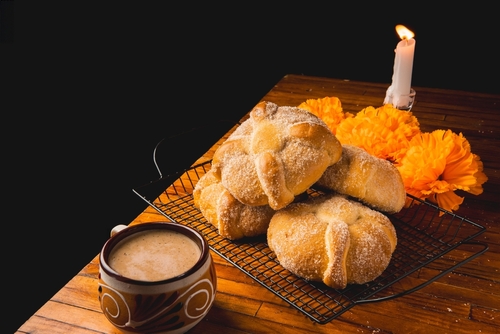
Pan de muerto, or bread of the dead, is a sweet bread decorated with bone-shaped dough and sometimes sprinkled with sugar, symbolizing the cycle of life. Its round shape represents the human body, the long shapes across the top symbolize bones, and the small round knot in the center represents the skull.
Regional variations exist across Mexico. In Mexico City, pan de muerto is typically sweet, flavored with orange zest and sugar. In Yucatan, bakers often use anise for a fragrant flavor and cover it in a sweet, red glaze, while in other regions, breads may include decorative patterns, sesame seeds, or even savory touches like cheese. Every family and bakery has its own recipe, making each loaf unique.
The bread is often eaten plain, but it can also be dipped in hot chocolate or atole (a hot, corn-based drink). It’s quite common for pan de muerto to be shared among family during meals and celebrations. Beyond being a tasty treat, it serves as a connection to ancestors, symbolically feeding the spirits who return to visit loved ones.
Calaveras
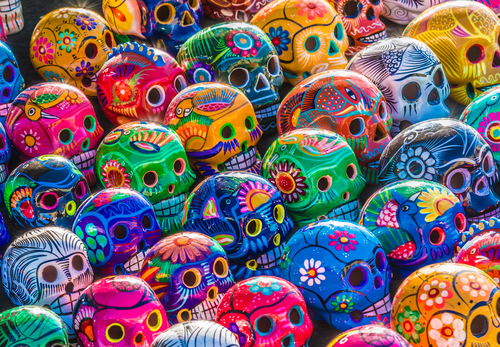
Calaveras, or skulls, are one of the most iconic symbols of Day of the Dead. They appear in edible sugar forms, papier-mache decorations, and hand-painted ceramic creations. Some calaveras are personalized with the names of loved ones, celebrating each individual while embracing the joyful acceptance of death.
Among the most famous calaveras is La Calavera Catrina, created by Mexican illustrator José Guadalupe Posada. Originally a satirical critique of European-influenced fashion, La Catrina became a central symbol of Day of the Dead in the early 20th century and continues to feature prominently in celebrations across Mexico.
Artisans often craft calaveras as beautiful works of art meant to be appreciated year-round. Hand-painted ceramic skulls, such as those found at markets like the Mercado Sonara on the outskirts of Mexico City, showcase vibrant colors and meticulous craftsmanship. Over time, calaveras have also entered modern pop culture outside Mexico, keeping the joyful spirit of Day of the Dead alive worldwide.
Other traditional dishes
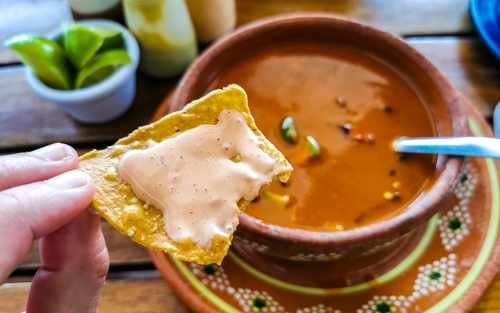
Other common Day of the Dead foods include tamales, mole negro (black sauce), calabaza en tacha (candied pumpkin), sopa Azteca, pepitorias (sweet pumpkin seeds), and atole. Many families also include the favorite foods of their deceased relatives, in a nod to the fact that the day is about them.
Preparing and sharing these foods creates opportunities for storytelling, cultural connection, and the passing of traditions from one generation to the next.
Flowers, decorations, and colors
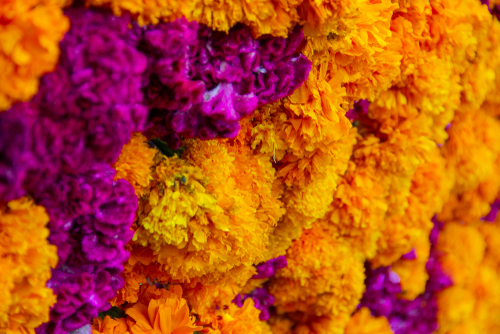
Flowers and colorful decorations are hallmarks of these traditions. Cempasúchil (marigolds) are believed to guide spirits with their vibrant color and scent. Bright colors dominate celebrations, contrasting with the mourning black often associated with death in other cultures.
Papel picado, colourful tissue-paper decorations, add movement and light to altars and public displays. Each color has a different meaning: purple for mourning, pink for celebration, white for purity, and orange for the sun. Candles are sometimes placed in the shape of a cross on altars, representing the four cardinal directions and, like the marigolds, guiding spirits home.
Homes, streets, and cemeteries come alive with these decorations, creating an experience that blends visual beauty with spiritual significance.
Regional variations across Mexico and beyond
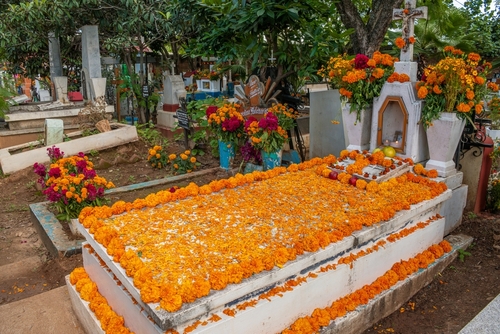
While the core traditions of Day of the Dead are widely recognized, celebrations vary across Mexico’s diverse regions.
Mexico City has emerged as a modern hub of celebration, blending traditional practices with large-scale public displays. The city hosts a massive Day of the Dead parade each year, featuring giant puppets, floats, and costumed performers. Meanwhile neighborhoods and families still maintain more intimate traditions, alongside this large-scale extravaganza.
Michoacán celebrates Night of the Dead, known for its elaborate cemetery vigils, where families decorate graves with candles, flowers, and food. Night-long festivities feature music, dance, and storytelling, highlighting community participation.
The region of Oaxaca is famous for its sand and flower carpets, intricate altars, and street parades with masks and costumes. Indigenous and colonial influences are vividly intertwined here, reflecting that mix of traditions we mentioned.
In Yucatán, locals celebrate Hanal Pixán, the Mayan Day of the Dead, which focuses on traditional foods and rituals and reflects local indigenous beliefs. Families offer tamales and other local dishes, integrating pre-Columbian practices.
Day of the Dead celebrations outside of Mexico
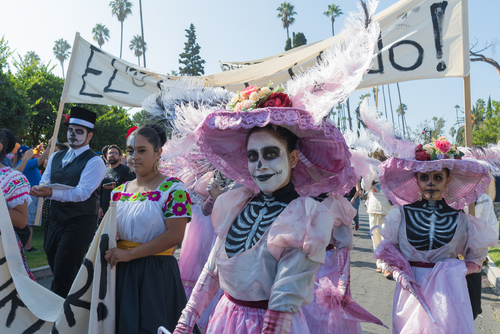
In the US, many immigrant families have kept these traditions alive through local celebrations. Cities with large Latin-American communities in particular, like Albuquerque, Chicago, San Antonio, and New York, host large-scale Day of the Dead festivals where families can gather, share traditions, and introduce them to the broader community.
Los Angeles hosts one of the largest Day of the Dead festivals outside Mexico, drawing thousands each year. In Texas and California, schools often incorporate altar-making projects, allowing second- and third-generation children to learn traditions in a hands-on way.
Public parades, school projects, and community ofrendas help preserve the cultural heritage while inviting participation from people of all cultures. Other Latin American nations, including Guatemala, Peru, and Ecuador, celebrate similar festivals to honor people’s ancestors.
How families worldwide can honor this tradition
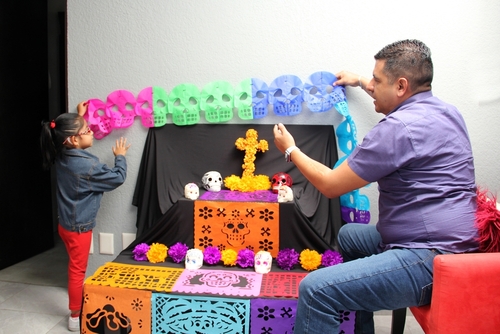
You can participate in Day of the Dead with respect and meaning, even if you’re outside Mexico. If you’re celebrating far from family or simply want to explore these cultural practices, here are a few ways you can honor loved ones who have passed, and connect with the spirit of the holiday.
Create an ofrenda at home
You can set up an ofrenda at home using photos, candles, flowers, and your loved ones’ favorite foods. Add handwritten notes, small keepsakes you might have from them, or objects that reflect their personality. If you have children, building the altar together can be a way to teach them about ancestry, memory, and cultural heritage while creating a shared, meaningful activity.
Learn traditional recipes
Try baking pan de muerto(s) or other traditional dishes yourself. It’s a great way for you to connect with Mexican culinary traditions and remember your loved ones through food.
Craft papel picado and decorations
You and your family can make colorful papel picado, paint sugar skulls, or create garlands. These hands-on crafts are fun, meaningful, and a great way to involve children.
Participate in community events
Many cities around the world now host local Day of the Dead celebrations, including parades, workshops, and community altars. You can join these events to see how others celebrate and share in the joy of the tradition.
Connect with heritage
If you have Mexican roots, take the opportunity to explore your family history. You can interview relatives, record stories, or create a scrapbook to connect with your heritage.
Keeping memories alive through tradition
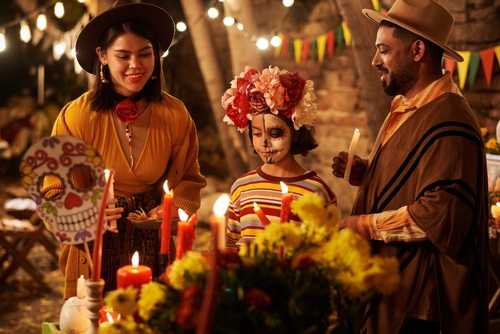
Day of the Dead traditions provide something that all of us need; joy, connection to culture and people who have passed, and a celebration of life. Through ofrendas, decorations, and storytelling, Latin American families honor loved ones and maintain spiritual ties across generations.
Whether you join in a community parade, cook a traditional dish, or simply light a candle at home, you can take part in Day of the Dead in a way that feels personal and meaningful. It’s your chance to honor family, memory, and life itself. It may be the Day of the Dead, but it’s a way of life.
FAQs
What is Day of the Dead, and when is it celebrated?
Day of the Dead, or Día de los Muertos, is a traditional Mexican holiday celebrated from October 31st to November 2nd. While many Latin American countries observe the holiday, Mexico is home to the most recognized traditions. It honors deceased loved ones and encourages their spirits to return briefly to reunite with families.
What are the key traditions of Day of the Dead?
Key traditions include creating ofrendas (altars) decorated with candles, flowers—especially marigolds—favorite foods, and personal items, making pan de muerto, decorating sugar skulls, and participating in festive parades. These practices celebrate life while acknowledging death as a natural part of existence.
What is an ofrenda?
An ofrenda is a traditional altar created to welcome and honor the spirits of loved ones. Families decorate them with photos, candles, flowers, food, and personal items to celebrate memory and connection.
How is Day of the Dead different from Halloween?
Unlike Halloween, which focuses on fright, costumes, and candy, Day of the Dead emphasizes memory, family connection, and cultural traditions. It is a joyful, reflective holiday where death is celebrated as part of life’s cycle.
How can I respectfully celebrate Day of the Dead at home?
You can set up a simple ofrenda at home with photos, candles, flowers, and favorite foods of loved ones. Learning traditional recipes, making decorations like papel picado, and attending local cultural events are other ways to participate respectfully.

